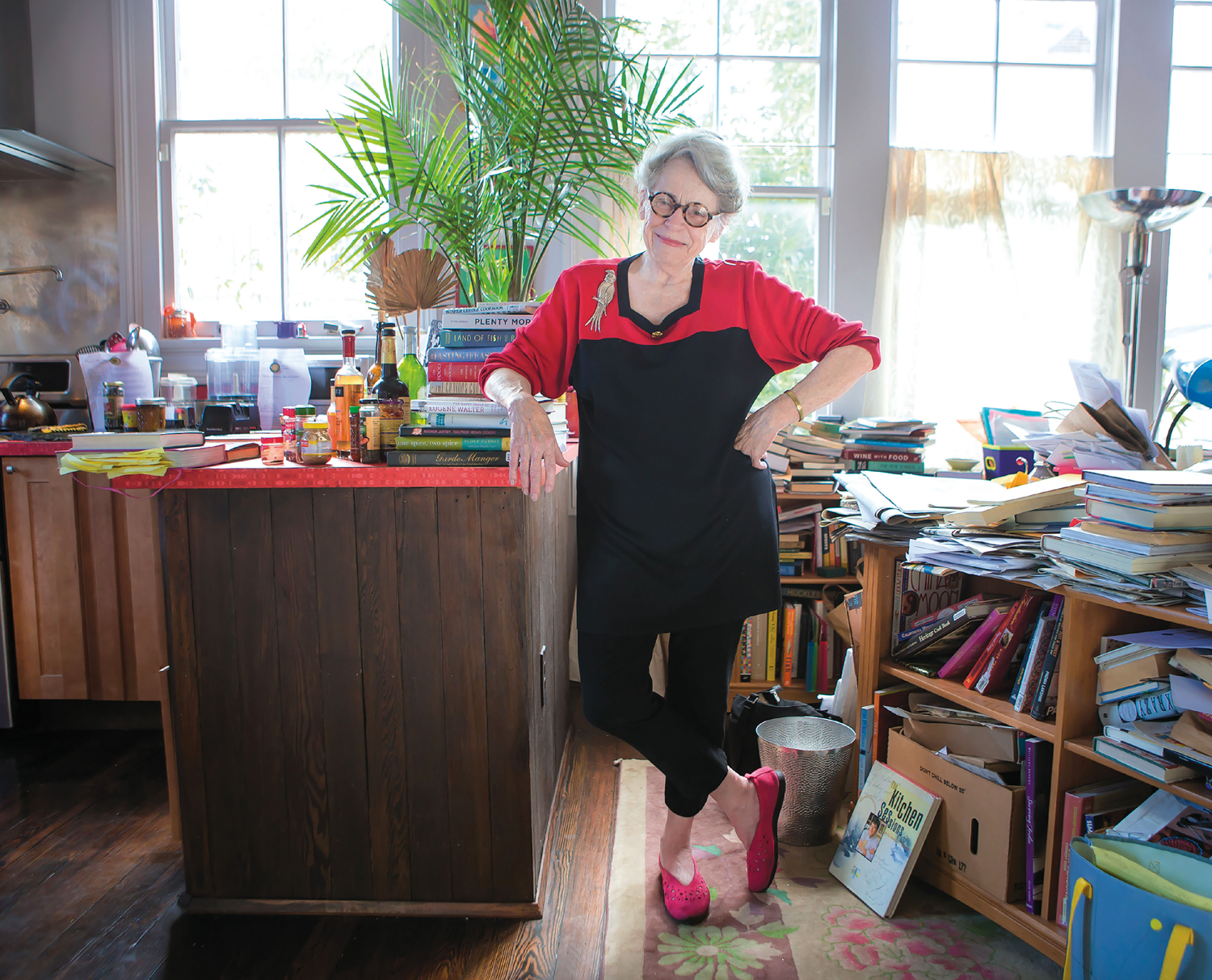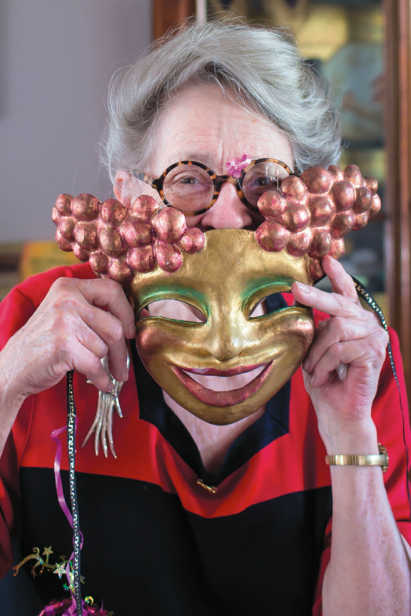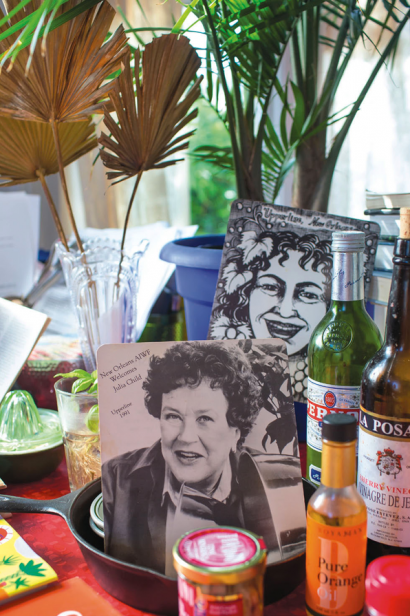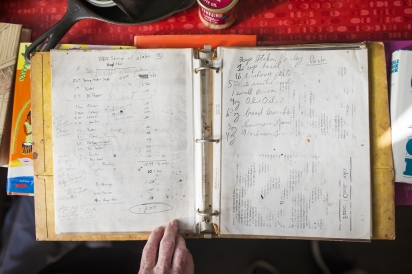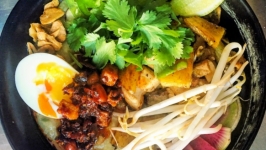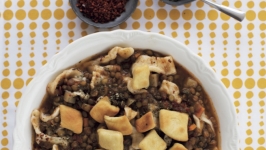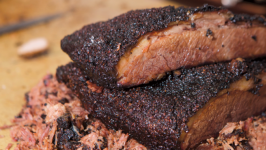JoAnn Clevenger: A New Orleans Icon
The iconic owner and maître d’ of Upperline bounces back and forth between tables like a pinball every night, with a sprightliness that belies her 78 years. She’s easily spotted by her “uniform”—picture Jean-Luc Picard’s redand- black tunic as a mod Lord & Taylor dress—topped with a teetering tousle of a top bun, most commonly seen as a blur against the backdrop of her New Orleans art collection clamoring for diners’ attention on Upperline’s crowded dining room walls. She works in a flash with an Old World flair and attention to detail that captivates, greeting regulars with hugs and her signature throaty cackle, manicuring table settings and taking reservations at the host stand, explaining one of her favorite works of art framed above a corner two-top, or leaning over to sing “Happy Birthday” as if she were part of the family of revelers.
The James Beard Award–nominated restaurateur is part New Orleans ambassador, part mischievous Creole muse, and known as the best hostess in the Crescent City. I had to wait until after the dinner rush to interview JoAnn Clevenger one-on-one, so I returned the following day to talk about all things Creole, her unique style of hospitality and how she’s come to deliver what she describes as “classic New Orleans with adventure.”
The Key to New Orleans
I moved to New Orleans when I was 19, when I met my first husband, who introduced me to this entire coterie of interesting people: his friends, in the French Quarter, which was full of people who considered themselves outside the mainstream, whether they were artists, or preservationists, or musicians, or people who ran the Asian restaurants on Decatur Street, or seamen coming in and out of town. It was a continual swirl of wildly different people, which I think is the key to New Orleans.
How Upperline Came to Be
I never planned to open my own restaurant, but when I decided to buy our building [Upperline] and persuaded my husband to take out a second mortgage on our house, I gave up some initial thoughts of creating a neighborhood hangout. It ended up as a collaboration between my son and first chef, Jason, who I had persuaded to leave his job as an executive chef in the Quarter, to create a mixture of some southern, some Creole, some French—to ultimately reflect the spirit of New Orleans.
Working Hard & Finding Beauty
I think the combination of reading books, growing up poor and being raised by hardworking role models—my mother, father, grandparents— who I saw achieve competence in everything they did—all created what I am and do today. I was lucky to see my role models work hard, but they also had the ability to look for beauty and find it. In Louisiana, there’s something called “cooking pears.” Pear trees grow well here, but they’re a little bit too hard to eat, so you put them up in jars for the winter. Every year, my grandmother would put halved pears in quart jars and she would color them. Some of them were pink and some were yellow and some were green. She’d put her pear jars up high along wooden shelves on her back porch and from inside, the light streaming through the pears looked like a stained-glass window.
JoAnn Clevenger: A Girl Scout with Gumption from Southern Foodways on Vimeo.
The Evolution of Creole
Creole is unique in that it’s a wild mix of cuisines. There are Cajun and French and African and Caribbean and southern influences. And it’s constantly evolving. For instance, after Hurricane Katrina, the Latino community’s contribution to Creole started to shape its modern-day evolution. Items like cilantro and different chili peppers started appearing in grocery stores all around the city after the hurricane, because hundreds and thousands of Latinos came to New Orleans to help rebuild. And of course, their food and cultural mores and traditions influenced Creole. The Vietnamese community has influenced Creole over a long period of time, too. There has been a Vietnamese farmers market in East New Orleans for a number of years, because traditional Vietnamese ingredients, like different varieties of basil, weren’t available in local supermarkets.
Participation as Pleasure
Having a meal at a restaurant is a special moment—because you are the star. You’re not a passive onlooker. You are a participant. You interact with the wait staff. You ask questions and you get answers. Even the details of plating can create unique interactions. For instance, almost all of our sauces [at Upperline] are served on the side so people can decide how to create their own experience. I always tell people, “This way you can have some, none or a lot.” It’s a way to discover what it is they like or don’t like and they get to learn more about Creole along the way. It becomes an adventure.
Her Signature Dish
When I first moved to New Orleans, every restaurant had shrimp remoulade on the menu, and it was always served on a small oval platter with slivered iceberg lettuce and five or six shrimp laid in a row, with ribbons of red remoulade on top. I was intrigued the first time I saw it because I didn’t even know you could eat shrimp cold. (I thought shrimp were only fried.) So when I [invented] that way of putting shrimp remoulade together with fried green tomatoes, it was inspired by that initial fascination, but also my upbringing. Growing up, my mother and grandmother would occasionally cull a green tomato so the branches wouldn’t break. You wouldn’t have a lot at one time, so they were always a side dish. So when I heard they were making a movie [Fried Green Tomatoes] about green tomatoes, I thought, “I want to make a dish, not a side to a pork chop.” So I brainstormed and thought, “Aha. We’ll put the shrimp remoulade on top.” That was 1992 and nobody copied it for three years. Then, by and by, it started appearing in hundreds of restaurants. Now think of how many people have enjoyed that dish around the world. Millions! It became like a stone dropped in a pond, with ripples that keep going farther and farther away.
A Benevolent Circle
My job is full of challenges, but also extremely gratifying, tangible benefits— and the best thing is that my learning curve never stops. Some days it can be exciting, and sometimes it’s not so exciting—but it’s still thrilling to me. So you make an effort and use the knowledge you’ve acquired and absorbed that morning or 20 years before and it all culminates to create an experience for people. And when other people appreciate what you’ve created, that joy completes the circle. I think of it as “a benevolent circle,” not a vicious circle. It’s a gift. That’s the most precious thing people say to me, that I do what I do as a gift to others.
This interview has been condensed and edited for length and clarity.
Local Taste: Cajun-Creole Comfort in Astoria
For those seeking authentic New Orleans fare, look no further than Sugar Freak in Astoria. They moved into their spacious, inviting new digs on 30th Avenue this summer, where they’re serving up all the same classics. Where else can you find a menu full of po’ boys, glutton-approved mac & cheese, alligator tail and beignets (to dip in a bananas foster cream sauce), all set to be washed down with a Big Easy cocktail, the Sazerac?
Upperline Restaurant | @upperlinerestaurant
Sugar Freak | @sugarfreaknyc


